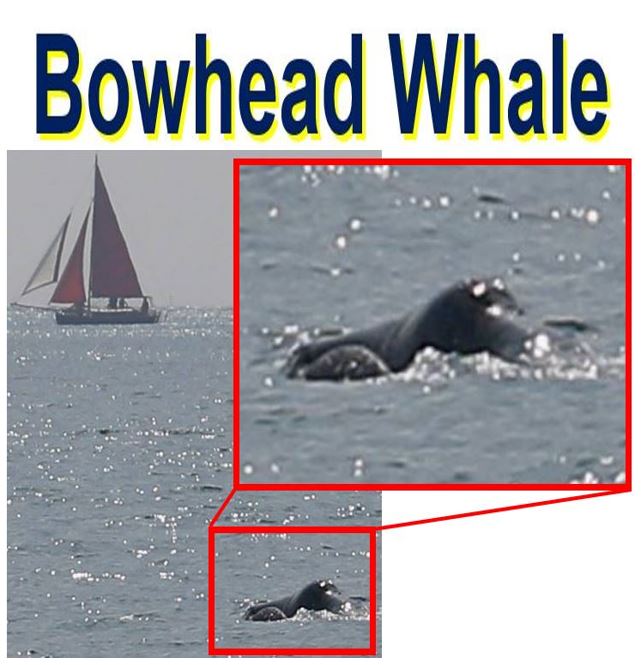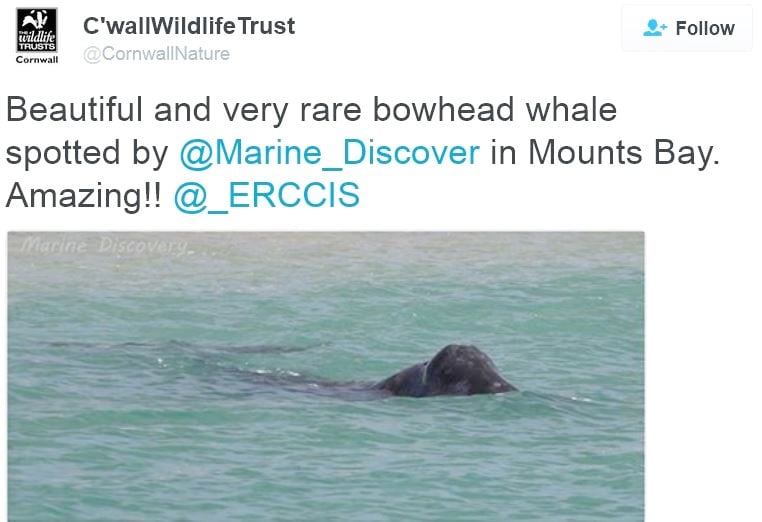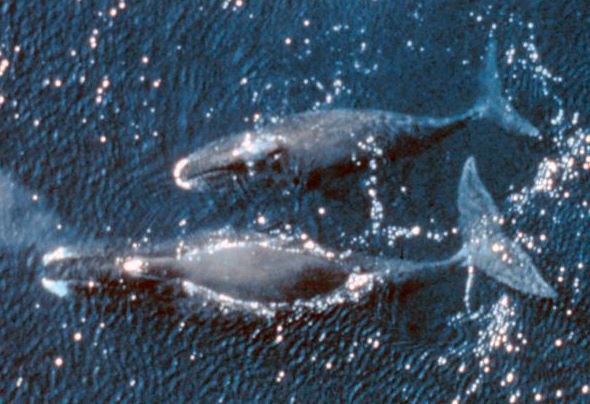Sightings of bowhead whales are extremely rare in British waters. One individual was spotted off the Cornish coast on Sunday swimming in shallow waters at Long Rock Beach, approximately one mile (1.6 km) east of Penzance and 1.5 miles (2.4 km) west of Marazion.
This is the second sighting of a bowhead whale (Balaena mysticetus) off the British coast since February 2015, when one was observed in the waters surrounding the Isles of Scilly, an archipelago off the southwestern tip of the Cornish peninsula.
According to the Sea Watch Foundation, a charity that monitors the numbers and locations of whales and dolphins, Sunday’s sighting – which was 7 metres (23 feet) long – and last year’s were both of juveniles. Adult bowheads can reach as long as sixty-five feet in length.
 In this image, the bowhead whale’s distinctive jaw-line is clearly visible. (Image: Marine Discovery/Sea Watch Foundation)
In this image, the bowhead whale’s distinctive jaw-line is clearly visible. (Image: Marine Discovery/Sea Watch Foundation)
Initially spotters thought it was a humpback whale
Sea Watch Foundation said an unidentified marine creature was seen near the shore by regular marine mammal observer and medic Dave Jarvis of BDMLR (British Divers Marine Life Rescue).
Local boat operators, Marine Discovery Penzance, went to the area where the animal had been spotted to check out the report. Initially, the operators though it might be a humpback whale. Dr. Marijke De Boer, a whale researcher who was on board, suspected the creature was, in fact, a bowhead whale.
With its distinctive head shape and jaw-line, and lacking a dorsal fin, the bowhead whale looks quite different from the other twenty-nine species of * cetacean, which occur in British waters.
* Cetacean: whales, porpoises and dolphins belong to a single group of marine mammals called the cetaceans. They are marine mammals that evolved from their land-mammal ancestors approximately 55 to 60 million years ago and have adapted perfectly to living in water.
 Image Bowhead Whale off coast of Cornwall. The species lives entirely in fertile Arctic and sub-Arctic waters, unlike other whales that migrate to low latitude waters to reproduce or feed. (Image: twitter.com/CornwallNature)
Image Bowhead Whale off coast of Cornwall. The species lives entirely in fertile Arctic and sub-Arctic waters, unlike other whales that migrate to low latitude waters to reproduce or feed. (Image: twitter.com/CornwallNature)
Sea Watch Foundation made the following comment on its website:
“With excellent images having been widely circulated, Sea Watch Foundation were able to add to the confirmation that this Mount’s Bay animal was indeed a bowhead whale and a very significant sighting indeed!”
“The first sighting of this species was just last year when a mystery whale was sighted off the Isles of Scilly. Back in February 2015, Sea Watch Foundation led a world-wide discussion into the identification of this particular visitor and were able to confirm with arctic whale experts that the first bowhead whale for the UK and in fact, elsewhere in Europe (south of the Barents Sea) had been recorded in Cornwall.”
Experts said that this time round the photographic evidence was considerably clearer, compared to what they had last year, which meant that in order to confirm the species they did not require international collaboration.
Climate change is warming up our atmosphere and oceans, say scientists. Plants and animals, including marine creatures and birds, are migrating geographically – venturing out into new regions. It is likely that in future we will be seeing more ‘exotic’ animals and plants in and around the British Isles.
Earlier this month, a Dalmatian pelican (Pelecanus crispus) was observed in Britain for the first time in several hundred years. Hundreds of bird enthusiast travelled to Land’s End in Cornwall to see whether they could get a view of the huge bird.
 According to the National Oceanic and Atmospheric Administration: “Bowhead whales are large, rotund black whales, with enormous heads that are about 1/3 of the total body length of adult whales. Bowhead whales used to be referred to as Greenland whales and sometimes even Greenland right whales. They are difficult to study because they live in the Arctic and spend a great deal of time under ice and water.” (Image: Wikipedia)
According to the National Oceanic and Atmospheric Administration: “Bowhead whales are large, rotund black whales, with enormous heads that are about 1/3 of the total body length of adult whales. Bowhead whales used to be referred to as Greenland whales and sometimes even Greenland right whales. They are difficult to study because they live in the Arctic and spend a great deal of time under ice and water.” (Image: Wikipedia)
Two or three – same individual?
Regarding this month’s sighting and last year’s, the Sea Watch Foundation said:
“This new sighting may well be the same individual as was seen off St Martin’s on the Isles of Scilly last year. It is impossible to confirm, given the quality of the initial images. With close views, bowhead whales can be individually identified by looking at natural marks and callouses which build up over time.”
Last week, the Foundation received a report of a mystery whale sighting at Bénodet, off the coast of Brittany, North West France. After examining photographic evidence, the foundation believes this was also a bowhead whale, and possibly the same animal that was spotted on Sunday. “This being so, it would make the sighting in Cornwall yesterday the third for the species in Europe,” the Foundation added.
Video – Bowhead whale off Cornish coast
https://t.co/ZWQoP0cQHo video of the #bowhead #whale that was in Mount’s Bay today. @CornwallNature @MC_org @MARINElife_UK @SeaWatchersUK
— Marine_Discovery (@Marine_Discover) 15 May 2016
